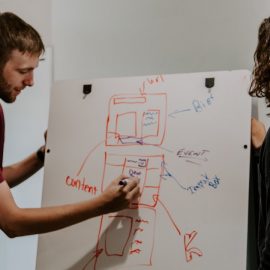

This article is an excerpt from the Shortform book guide to "Tribal Leadership" by Dave Logan, John King, and Halee Fischer-Wright. Shortform has the world's best summaries and analyses of books you should be reading.
Like this article? Sign up for a free trial here .
Do your employees lack ambition? How can you light a fire under them and get them motivated and engaged?
Some employees just don’t care. They show up and do the bare minimum. As a result, the workplace mood and your bottom line suffer. This is what Stage 2 culture is like. The book Tribal Leadership helps you understand this stage and shows you how to cultivate individual ambition in your team so that it can progress to Stage 3 culture.
Keep reading for Tribal Leadership advice on how to deal with disengaged employees.
Disengaged Employees
At Stage 2, an apathetic and disinterested mood prevails. According to Tribal Leadership authors Dave Logan, Halee Fischer-Wright, and John King, Stage 2 individuals are typically passive, disinterested, and disconnected from their work. Because of this, they rarely produce creative ideas or innovate solutions to tough problems. Further, Stage 2 individuals avoid accountability: When a few good ideas do arise, people rarely get around to executing them.
Stage 2 individuals allow their circumstances to define them, and they often fixate on a tangible problem that supposedly prevents them from improving. For example, they might complain that the budget is too small, they lack enough time, or that there’s a bad apple spoiling the bunch. However, the authors explain that resolving Stage 2’s problems won’t fix the complaints because Stage 2 individuals have committed to feeling trapped by their circumstances, and they’ll constantly look for more reasons to complain. You must learn how to deal with disengaged employees in a way that moves them forward into Stage 3.
Stage 2 cultures are common at public-facing government offices such as the post office and among low-ladder workplaces like chain retail stores. These jobs, the authors say, give employees little creative license or autonomy, and higher-ups generally treat the employees as replaceable. This causes Stage 2 workers to experience work as a dehumanizing daily grind. Given this demotivating experience, Stage 2 tribes survive by bemoaning their circumstances and working for the weekends.
| Robert Kegan’s Developmental Stages Stage 2 of Tribal Leadership corresponds to Robert Kegan’s model of ethical, social, and cognitive development. For clarity, we’ll refer to it as “the communal mode” when comparing it to Tribal Leadership’s Stage 2 throughout this section. Stage 2 exists in the communal mode: Individually, people understand themselves based on how others see them. Collectively, everyone follows the group’s norms while avoiding taboos. People form reciprocal relationships, giving and taking more or less equally, and people generally empathize with each other by default. Since group norms are paramount, people in a Stage 2 office show solidarity when someone complains about work. (Think how uncommon it is that someone would rebuke another who prompts him to agree about “how crappy work is.”) Adding Kegan’s model illuminates why Stage 2 cultures perpetuate a low bar of mediocrity—in the communal mode, it’s very difficult to break the status quo. Doing so would mean losing many of your relationships and being ostracized. |
Three Key Markers of Stage 2
The authors explain that like Stage 1, Stage 2 has three key markers: a view of values, shared language habits, and a characteristic relationship style, as follows:
Marker #1: Apathetic disregard for values. Since Stage 2 individuals let their circumstances define them, they have little integrity. According to the authors, they feel that values have failed them in the past and are therefore worthless.
Often, this happens because management introduces “values” to the workplace in a heavy-handed way. For instance, many organizations pay lip service to values, printing them out and producing the trappings of a values-driven workplace. At the same time, the higher-ups ignore their supposed values and treat employees like cogs in a machine. As the authors explain, this makes employees feel used and unvalued, and it reinforces the notion that “values” are simply a meaningless corporate ploy.
(Shortform note: Another reason values often fail is that top-down plans don’t account for the actual boots-on-the-ground situation. Put another way, planned values reflect leadership’s ideas, but they might completely miss how employees actually feel or behave on a day-to-day basis. This disconnect between espoused values and how people actually behave causes people to doubt the values. To counteract this, support the people who do live your company’s values and don’t be afraid to let go of those who don’t.)
Marker #2: Commiserating language. A Stage 2 tribe acts as an echo chamber for complaints about the workplace. Tribe members fixate on how the higher-ups mistreat them and on similar gripes: the oppressive “system,” getting a bad start in life, or lacking the skills to move up. According to the authors, this commiseration reinforces the tribe’s passive, disinterested mood.
In addition, Stage 2 tribes trash talk their bosses, as in the cartoon “Dilbert,” which captures the relationship between Stage 2 tribes and their “evil bosses.” These bosses treat employees callously, and that reinforces the unmotivated, unhappy Stage 2 atmosphere.
(Shortform note: Psychologists have studied the science of commiseration, which they refer to as co-rumination: problem-focused talk that rehashes and dwells on problems without seeking solutions. While we commonly believe that venting anger over workplace stresses is healthy, research has found that it leads to increased cortisol, a hormone related to stress, and that dwelling on negative thoughts increases your risk of mental illness. Instead of commiserating, find ways to point out the positives and focus on problem-solving rather than griping.)
Marker #3: Tenuous relationships. Since Stage 2 tribes subsist on commiseration, tribe members form tenuous relationships. Without something deeper to unite people, such as meaningful and inspiring work, these relationships don’t grow beyond the shallow support offered by mutual disenchantment with work. According to the authors, since no one quite knows each other, a Stage 2 workplace often feels gloomy and tense.
(Shortform note: If you find yourself in an unhappy Stage 2 workplace, there are several options that might help. The Harvard Business Review suggests that you first face how you feel; by experiencing the feeling of unhappiness instead of avoiding it, you can gain clarity on the problem and why you feel that way. Then, face up to whether or not you can change your circumstances. If you can’t, try finding the positives and practice “radical acceptance” of where you are now, for now. Finally, make a plan to either improve your current situation, or find a new one.)
Paths to Stage 3: Cultivate Individual Ambition
The authors explain that coaching a Stage 2 individual to Stage 3 centers on sparking her ambition by helping her to see and cultivate her strengths. When she realizes that she can achieve more and become a successful individual, she’ll begin to level up her work and her life.
When coaching individuals to Stage 3, look for those who seem ready to leave Stage 2 behind. Often, these are younger employees who haven’t sunk too deeply into Stage 2’s miserable mire. Work with one employee at a time and use the authors’ two steps:
- Step #1: Help her recognize her strengths. To gain her trust and kindle her ambition, give her feedback that highlights her strengths and accomplishments. With a positive tone, encourage her to explore skills that she could develop further, and give her small projects that allow her to exercise these skills.
- Step #2: Encourage her to form relationships with Stage 3 individuals. To reach Stage 3, she’ll need to learn from Stage 3 individuals. Encourage her to build relationships with Stage 3 individuals who have a propensity to mentor up-and-coming prospects. According to the authors, this helps her to see her own potential and strive upward.
| Encourage Nonlinear Development While we’ve long operated on the notion of linear career development, Tania Luna of Lifelabs Learning writes in the Harvard Business Review that today, a linear career path doesn’t always make sense. Instead, today’s workers must learn to navigate an unpredictable, ever-changing landscape of opportunities, finding a less direct path to career success and fulfillment. So when using Tribal Leadership’s coaching tactics, help your mentees understand that they don’t necessarily need to pursue a linear career. For young workers without clear career goals, it can be liberating for them to hear that they can instead develop their skills and find a less traditional path to success. In addition, encourage them to develop transferable skills, such as writing or productivity, so they have more options when searching for roles. Last, use “small experiments” to help employees try out new skills and explore areas in which they might want to develop. |
Two main changes mark the individual’s transition from Stage 2 to Stage 3, according to the authors:
- Change #1: She starts using Stage 3 language. Instead of expressing that her life sucks, she’ll start to recognize her own potential—and she’ll express that with language like, “I’m awesome,” or “I can do this.”
- Change #2: She takes on the Stage 3 attitude. She’s begun to recognize her abilities and develop her confidence, so the individual will start to feel and express the competitive, ambitious attitude characteristic of Stage 3, often by talking a big game.
(Shortform note: To further kindle an employee’s ambition, find what motivates them and give frequent feedback. By finding what’s intrinsically motivating to an employee, you can assign her to projects or tasks that excite her the most. And by giving frequent, supportive feedback, you help her clearly see how she’s doing and stay on track.)

———End of Preview———
Like what you just read? Read the rest of the world's best book summary and analysis of Dave Logan, John King, and Halee Fischer-Wright's "Tribal Leadership" at Shortform .
Here's what you'll find in our full Tribal Leadership summary :
- Why culture makes all the difference when it comes to business
- The five stages of elevating a group's culture
- How to know which stage your work culture is in






